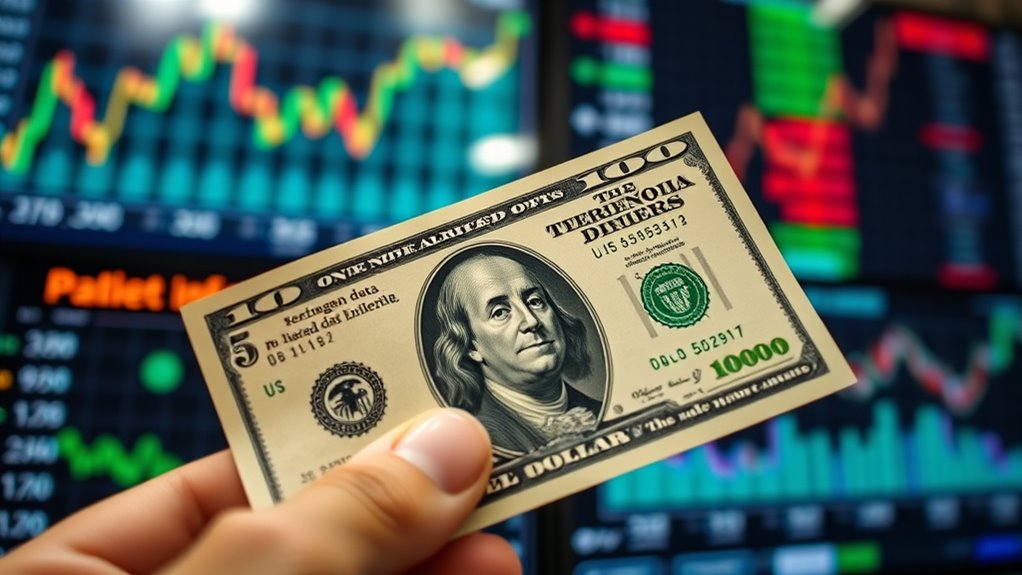You’ll see the dollar strengthen after strong July inflation data, which shows prices rising across consumer and producer levels. This signals persistent inflation pressures, boosting expectations of higher interest rates from the Federal Reserve. As the dollar gains about 0.4%, markets react to these signs, and the currency remains resilient. If you want to understand how these inflation trends could affect your investments and currency movements further, there’s more to explore below.
Key Takeaways
- Strong July inflation data signals persistent price pressures, boosting expectations for higher interest rates and strengthening the dollar.
- Elevated inflation reduces the likelihood of a Federal Reserve rate cut in September, supporting dollar gains.
- Increased inflation indicators, such as PPI and core CPI, reinforce market confidence in a robust dollar rally.
- Widening bond yield gaps driven by inflation expectations make the dollar more attractive to investors.
- Market sensitivity to inflation signals leads to dollar appreciation amid global economic uncertainty.

The dollar has gained strength following recent inflation data that signals ongoing price pressures in the US economy. You’ve probably noticed the dollar index (DXY) climbing to around 98.23 on August 14, 2025, marking a roughly 0.40% increase after the latest inflation figures. This uptick reflects traders’ reactions to the data, which suggests that inflation remains persistent despite some recent moderations. The Consumer Price Index (CPI) for July rose 0.2%, a slight slowdown from June’s 0.3%, but it’s still the strongest monthly increase since January. The annual inflation rate nudged up to 2.8%, the highest since February, driven partly by retailers passing on higher import duties on household furnishings and recreational goods. You can see that prices for used cars and airline fares increased, while gasoline and new car prices declined slightly in July. Meanwhile, core inflation—excluding volatile food and energy—edged up to 3.0% annually, with monthly core CPI rising 0.3%, the sharpest in six months. These figures demonstrate that inflationary pressures aren’t easing notably, which is a key factor behind the dollar’s recent rally.
The stronger inflation data bolstered the US dollar’s appeal, causing the dollar index to climb despite some recent volatility. You may recall that the July Producer Price Index (PPI) surged 0.9% month-on-month, marking the largest jump in three years. This increase signals that wholesale prices are rising at a pace that could feed into consumer inflation, further supporting dollar strength. Additionally, core PPI, which excludes food, energy, and trade services, rose 0.6% monthly and 2.8% annually, revealing persistent inflation at the production level. Labor market data also plays a role; jobless claims continue to fall, indicating a tight labor market that sustains wage growth and supports ongoing inflation. Although the dollar weakened slightly—by about 0.33% to 0.39%—over the past month, the recent inflation data helped reverse that trend, highlighting market sensitivity to inflation signals.
These inflation figures have considerable implications for Federal Reserve policy. Investors are now less optimistic about a rate cut in September 2025, as the stronger inflation data suggests the Fed might need to keep rates steady or even raise them. Morgan Stanley analysts expect inflation to peak in the third quarter, which could delay any easing measures and keep dollar support strong. Elevated inflation, partly driven by tariffs and supply chain issues, suggests the Fed may prioritize maintaining higher interest rates to combat price pressures. While the labor market remains resilient, some signs of softness exist, creating a complex environment for the dollar. Globally, the US’s economic growth forecast at 2.7% for 2024 outpaces other developed markets, and the widening gap in bond yields—highest since 1994—further favors the dollar. Investors holding over $30 trillion in US assets continue to view the dollar as a safe haven, although increased FX hedging among foreign investors could limit further gains. Overall, the recent inflation data solidifies the dollar’s position as a dominant global currency amid ongoing economic and policy uncertainties. Additionally, the persistent inflation indicates that ethical hacking strategies may play a crucial role in safeguarding financial institutions against emerging cyber threats.
Frequently Asked Questions
How Does Inflation Impact Long-Term Dollar Trends?
Inflation impacts long-term dollar trends by influencing monetary policy and interest rates. When inflation rises, you might see the Federal Reserve hike rates to curb it, making the dollar more attractive. However, persistent inflation can erode competitiveness and lead to capital outflows, weakening the dollar over time. Your outlook depends on how inflation and policy responses evolve, affecting the dollar’s strength and stability in the long run.
What Are the Global Effects of a Stronger Dollar?
When the dollar gets stronger, you’ll see it impact global trade and investments. U.S. exports become pricier for foreign buyers, reducing demand. Emerging markets with dollar debts face higher costs, risking instability. Investors attract to U.S. assets, pulling capital away from other regions. Overall, a stronger dollar can slow global growth, tighten financial conditions, and disrupt supply chains, affecting economies worldwide and making international markets more volatile.
How Do Inflation Reports Influence Federal Reserve Policies?
Inflation reports have a powerful impact on Fed policies — they can change everything in an instant. When inflation exceeds targets, you’ll see the Fed tighten rates to curb demand. If inflation eases, they may pause or slow down. These reports guide the Fed’s messaging, shape market expectations, and help balance the goals of controlling inflation while supporting employment. Fundamentally, inflation data is the key to the Fed’s next move.
What Sectors Benefit Most From a Strengthening Dollar?
You’ll find that sectors like finance, technology, and retail benefit most from a strengthening dollar. The financial sector attracts more foreign investment, boosting assets and profits. Technology firms gain from cheaper imported components, while retail benefits from lower costs for imported goods. Conversely, export-dependent industries face challenges as their products become more expensive abroad, reducing demand. Overall, a strong dollar favors sectors with domestic focus and those involved in financial services and technology.
How Might Currency Markets React to Future Inflation Data?
Imagine the currency market as a weather vane, swinging wildly with inflation data. When future inflation figures surprise to the upside, expect the dollar to surge like a storm, driven by expectations of higher interest rates. Conversely, if inflation cools unexpectedly, the dollar may weaken, like a fading gust. Your investments will feel this volatility, reacting swiftly to new inflation signals that shift the global economic forecast.
Conclusion
You can see how the dollar’s recent rally reflects investor confidence in the economy, especially with July’s inflation rate coming in at 3.2%, the lowest since 2021. This decline suggests that inflation pressures are easing, encouraging dollar strength. As the dollar advances, it impacts global markets and trade balances. Keep an eye on upcoming data releases, since even a slight shift could influence the dollar’s trajectory and overall economic stability.









